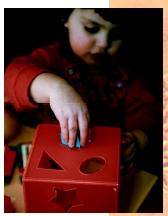Learning
Learning produces a relatively long-lasting change in behavior as a result of experience. The ability to learn, to gain from experience, allows animals to adapt to and cope with variable environments and therefore contributes to reproductive fitness.
Habituation and Sensitization
Habituation, the most rudimentary learning process, can occur in single-celled animals as well as all higher animals. Habituation is the reduction of a response to a stimulus as a result of repeated low-level stimulation. For example, protozoans contract when touched. However, repeated touching causes a gradual decrease in this response and is not the result of fatigue or sensory adaptation but rather true learning. In fact, habituation in planaria survives regeneration; when a planarian is split in two, both new planaria exhibit the response learned by the original one. Increased response magnitude, or sensitization, can also occur to a repeated stimulus if it is of high intensity or aversive (unpleasant). Sensitization has only been observed in multicellular organisms with at least a rudimentary nerve network.

Animals with central nervous systems can learn through more complex processes that allow them to adapt to a larger variety of environmental circumstances. The main types are classical conditioning, operant conditioning, imitation, and imprinting.
Classical Conditioning
Classical conditioning (also called Pavlovian conditioning after its discoverer Ivan Pavlov) involves the creation of a conditioned reflex. In a classic experiment, a bell (neutral stimulus) is rung just before meat powder (unconditioned stimulus) is squirted into a dog's mouth. The meat powder produces the reflexive response of salivation (unconditioned response). If the bell is rung and followed by a squirt of meat powder into the mouth many times in succession (with a rest period between presentations), eventually salivation will occur to the sound of the bell before the meat powder is squirted into the mouth. The bell is now a conditioned stimulus, and the salivation to the bell is now called a conditioned response; they comprise a new conditioned reflex. The conditioned response will be sustained as long as the ringing of the bell continues to be correlated with the presentation of the meat powder. As in this example, conditioned responses are probably adaptive because they prepare the organism for the forthcoming unconditioned stimulus.
Operant Conditioning
A second type of conditioning, operant conditioning, does not involve reflexes at all. Rather, certain kinds of voluntary behavior, usually skilled motor behavior, are affected by the consequences that follow. Stimuli associated with particular contingencies do not force a response as in the case of reflexes. Rather, such stimuli alter the likelihood that a behavior will occur. For example, the "open" sign on the door of a restaurant makes it likely someone who is ready for a meal will open the door because of past experience.
In general, pleasant events increase the likelihood of, or reinforce, voluntary (operant) behavior, and unpleasant events weaken or punish operant behavior. New behavior can be created through operant conditioning using a procedure called shaping, or the reinforcement of successive approximations of a target behavior. For example, a dog can learn to roll over if a skillful trainer provides it with food and praise (the reinforcement) for closer and closer approximations of rolling over during a training session.
Imitation
Many species also learn through imitation. In general, it is a fast and efficient way of learning functional new behaviors. For example, in England some birds had learned to get milk by piercing the caps of milk bottles on doorsteps. Over a period of years, this behavior spread to several species of birds and other parts of the British Isles. There is disagreement about whether imitation is a special case of operant conditioning or an additional type of learning.
Imprinting
Imprinting is the development of an attachment to the mother or, if the mother is absent, any moving object close by during a certain brief period in the life of a young animal. For example, a newly hatched goose or duck will become attached to a shoe box, a human being, or any object if the goose or duck is removed from its nest shortly after hatching. Comparable behavior can be observed in many mammal species such as sheep, deer, and dogs. The adaptive value of following a mother is obvious. Again, there is disagreement over whether imprinting is a special case of operant conditioning or a unique type of learning.
SEE ALSO Behavior, Genetic Basis of ; Natural Selection ; Nervous Systems
Lynda Paulson LaBounty
Bibliography
Abramson, Charles I. Invertebrate Learning: A Laboratory Manual and Source Book. Washington, DC: American Psychological Association, 1990.
Chance, Paul. Learning and Behavior, 4th ed. Pacific Grove, CA: Brooks Cole, 1999.
Mazur, James E. Learning and Behavior, 5th ed. Upper Saddle River, NJ: Prentice Hall, 2001.
Comment about this article, ask questions, or add new information about this topic: